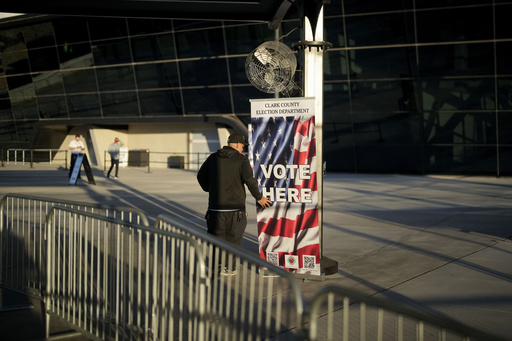
LAS VEGAS — In a significant political shift, registered Republican voters have narrowly surpassed Democrats in Nevada, marking the first time this has occurred in nearly two decades. As of January, there are 187 more active Republican voters than Democratic voters, as per the latest report released by the Nevada Secretary of State’s office. The last recorded instance of Republican dominance in voter registration was back in 2007. Despite this shift, both major parties still lag behind nonpartisan voters, who now represent 33% of the 2.1 million active registered voters in the state.
This change underscores Nevada’s identity as a competitive state and may complicate Democrats’ efforts to hold onto two U.S. Senate seats and recapture the presidency. The party is grappling with the difficulty of re-establishing a foothold in Washington after experiencing a decline in registered Democratic voters since the pandemic. In January 2020, Democrats made up 38% of the electorate, leading the GOP by over 83,000 registered voters. However, since then, Republicans have been steadily gaining on that margin.
The most recent data shows that both parties account for just under 30% of active registered voters, with Republicans totaling 618,539 and Democrats at 618,352. It’s important to note that not all states register voters by party, making it challenging to analyze trends between states due to varying registration practices and political climates. Nevertheless, Republican registration growth is observable in other key battlegrounds too. For instance, in Pennsylvania, Democrats hold their smallest edge in voter registration in 50 years, with a gap that has shrunk dramatically from 1.2 million voters in 2008 to fewer than 200,000 today. Similarly, in Arizona, trends had appeared favorable for Democrats until they began to lose ground after 2022.
Dan Lee, a political science professor at the University of Nevada, Las Vegas, emphasizes this shift in Nevada as an indication of its status as a swing state, despite a trend of voting for Democrats in every presidential election since 2008, except for Trump’s narrow win in the state in 2024. “It’s not turning into a deep-blue state,” he stated.
The Nevada GOP attributes its recent increase in voter registration to efforts aimed at engaging voters ahead of the upcoming elections, including initiatives by the conservative group Turning Point to mobilize turnout. Alexander Watson, the executive director of the state party, expressed intentions to enhance these outreach efforts in future elections by promoting policies that resonate with voters in Nevada.
In response, Hilary Barrett, the executive director of the Nevada Democratic Party, highlighted their strategy to broaden appeal among nonpartisan voters and welcome moderate Republicans into the fold. According to AP VoteCast data, a significant majority of moderate voters, including 20% of moderate Republicans, cast their ballots for Kamala Harris in the 2024 election.
Political experts attribute the changes in Nevada’s voter registration landscape to a variety of factors and urge caution in interpreting the numbers, noting they can often be misleading. Chuck Muth, a conservative campaign consultant, pointed to regular voter roll maintenance and procedural changes in registration as contributing factors. For instance, following the November elections, Clark County, a Democratic stronghold, purged around 130,000 inactive voters from its rolls. Historically, more Democrats than Republicans tend to remain inactive in Nevada.
Furthermore, the Nevada Secretary of State’s office indicated a common decrease in active registrations post-election, as the National Voter Registration Act limits the removal of inactive voters within 90 days leading up to elections. In 2021, Nevada implemented automatic voter registration for individuals applying for a driver’s license or ID, registering them as nonpartisan if no party affiliation is indicated. This change has resulted in nonpartisan voters becoming the largest voting group in Nevada, a trend that shows no signs of abating.
Ultimately, Muth contends that the essence of electoral success lies beyond mere registration numbers; rather, it hinges on the ability to mobilize and turn out voters effectively.

